This week, could we colonise a planet beyond our own galaxy? What’s the greenest way to heat my home? And why do bright lights make some people sneeze? It's Q&A time! Chris Smith is joined by a panel of scientists to take on the questions YOU'VE been sending in. Joining him are chemist Ljiljana Fruk, physiologist Sam Virtue, mathematician and technology journalist Tim Revell and our very own physics boffin Adam Murphy.
In this episode
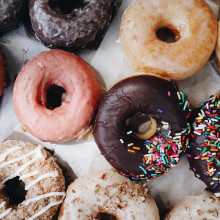
05:24 - Is sugar in fruit healthier than in doughnuts?
Is sugar in fruit healthier than in doughnuts?
Chris Smith put this sweet question from Annie to cambridge physiologist Sam Virtue. It also sparked debate among fellow panellists chemist Ljiljana Fruk and technology journalist Tim Revell...
Sam - Well, the answer to that is no, simply. And in fact actually some of the sugars that are commonly found in fruit might actually be worse for us than those found in doughnuts, in particular, sugar called fructose which its name comes in part from fruit. And so doughnuts will the made in the UK with your classic Tate & Lyle white granulated sucrose, fruit will contain the sugar this from fructose and this fructose has been shown in particular to be very harmful to our livers. Now it does have some advantages, which is maybe why it’s not quite so bad for us unless we take huge quantities, which is that it’s sweeter than sucrose and glucose so you may need less of it. Although that will appear to suggest doughnuts might be healthier than fruit, the truth is very different because whilst a doughnut might have slightly healthier sugar it does have vastly more of it. A normal sized apple has about 19 g of sugar, a doughnut has 48, but also the doughnut contains piles of fat so one normal sized apped maybe has 95 calories, a doughnut will have about 800 if it's the same size. So you need to eat eight apples to get about the same amount of calories.
Chris - Ljiljana "Fruk-tose"!!!??
Ljiljana - I'm glad you said that, yes! But it's very nice that you mentioned apples because there is one myth I want to enhance because I've just learned that you should really eat an apple a day to keep the doctor away because the apple peel contains a compound which is called quercetin. And it has been found that quercetin, if you give it to aged mice, they can actually become younger their cells become younger.
Chris - Is it an antioxidant or something?
Ljiljana - Well, it's antioxidants but it's also called anti-senolytic which means that it removes senescent cells which are a normal product of ageing. They are also called zombie cells, funnily, because they have enhanced metabolism but they don’t divide, and this quercetin from apples seems to removing these senescence cells and allowing normal, healthy cells to grow better.
Chris - So we should be saying an apple a day keeps dementia at bay rather than a doctor away?
Ljiljana - As well, yes.
Chris - But going back to your point, Sam, about the fact that there is a lot of sugar in fruit, why is fruit beneficial when because if you look at all the data we are being fed - excuse the pun - on a regular basis, we are being told to eat your five a day and that includes healthy portion of fruit so why is that good?
Sam - Obviously, as part of the advice on eating five a day there is a focus on eating a lot of vegetables as well in there and trying not have too much as your component of five a day. For example, only one helping is suggested to be fruit juice and, again, that’s because the sugar which you’re trying to limit, but what fruit has lots of great things in it like vitamins and minerals. And if you’re gonna eat something sweet because we all have to have some enjoyment in our lives, we can’t just all eat things that we think are boring and savoury. If you want something sweet, it’s not about the fruit is necessarily good, it is the fruit is sweet which is nice for you and it’s not as bad as a doughnut.
Chris - Tim looks relieved. He’s allowed the odd treat. You look terribly pleased when he said initially "oh, there’s loads loads in the doughnut and the fruit, and the fruit isn’t actually much better than the doughnut” and you went “excellent!” I saw your face, and when he said well,it’s actually not that good you looked really upset.
Tim - Well, the thing is doughnuts are amazing. And while she was talking I was just wondering why we can’t make something that has all the benefits of fruit but tastes as delicious as a doughnut.
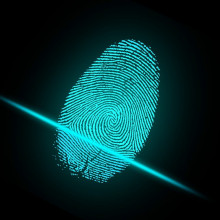
09:14 - How do fingerprint scanners work?
How do fingerprint scanners work?
Chris Smith received this question from Scientizscht on The Naked Scientists forum which sparked another question from fellow panellist, Adam Murphy. It was over to technology journalist Tim Revell with an answer...
Tim - You get them on mobile phones, you also get them in police stations and they all rely on the fact that everyone has a unique fingerprint. And if you look your fingers you can see that there's a series of ridges and valleys that are characterised uniquely to you, and the way that any fingerprint scanner works is it tries to take an image of that in various different ways. So, for example, some fingerprint scanners are basically just cameras, they take a photo of the edge of your finger and then they compare it to other photos of other peoples' fingerprints.
But on your phone, for example, most phones use something called a capacitance scanner. And what this is, is it's loads of little squares in a grid that when you put your finger on them they produce a little current and the current reacts slightly different than it does in the ridges and valleys, and that produces measurement that it can use to sort of uniquely identify you.
Chris - Adam?
Adam - Is there any way to fool them like can you tape a bit of sellotape to someone's finger and put it on the scanner and break in?
Tim - The thing is fingerprints are very intricate. In theory it is possible to do that absolutely and the software that analyses fingerprint scans is not perfect, it doesn't do a perfect image comparison between you and whatever fingerprint it’s looking at. Especially because, when you're putting your fingerprint down on a fingerprint scanner you don't always use the same bits. You do it bit at a funny angle, and that gives a slightly different measurement. So that means, in principle, yes you can trick them but is really quite hard to imitate someone else's fingerprint.
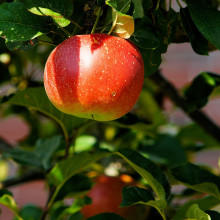
10:55 - Are cooked fruits less nutritious?
Are cooked fruits less nutritious?
Earlier on, physiologist Sam Virtue compared the sugar in fruit and doughnuts which motivated Rosemary to get in touch. Chris Smith asked him to cook up an answer...
Sam - I don't know the specific details with the apples but there are certainly some vitamins and minerals that will go away with cooking. And this is why cooking processes which are less stringent perhaps, so for example steaming rather than boiling, they will lead to less of the vitamins and minerals been leached away. So that is certainly the case that you can get a lot of benefits from it but there may be some things you lose.
Chris - So cook with care?
Sam - Indeed!
Chris - But obviously cooking is good because it kills microorganisms and bad for you things that are in there so there's a tossup, I suppose, between the benefits of releasing more calories by cooking and sterilising your food. But, at the same time, you end up with a higher loss of the goods things like vitamin C?
Sam - Absolutely. I think the benefits of cooking historically were vastly greater than perhaps they are now. I mean the certainly certain things that you would absolutely not want the raw even to this day, but a lot of things like fresh fruit and fresh vegetables. We think about going to supermarket and being a beautiful apple well, if you're living through winter and you don't have refrigeration and you've got a bushel of apples then it's a little bit of a different situation maybe 200 years ago.
Chris - There's also cyanide amygdalin which is in the seeds of apples which is not quite so good as the skin you are mentioning Ljiljana. I think I calculated that you'd have to eat about 54 kg of apples before you actually got a fatal dose of amygdalin to wipe out a human but there is still cyanide in the pips so maybe don't eat the core.
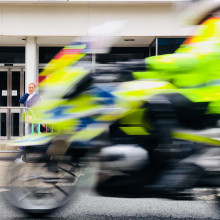
12:37 - Why are reflective jackets brighter at dusk?
Why are reflective jackets brighter at dusk?
Chris Smith received this question from listener Sam. It was over to chemist Ljiljana Fruk from Cambridge University to illuminate an answer...
Ljiljana - It's an interesting question as well. The super reflective jackets are, of course, relying on fluorescent dyes which are embedded in these jackets so that when you are driving your bike during the daylight you can be noticed because fluorescence is the strongest in the UV light during the daylight from the sun. And then you have reflective materials which are basically reflecting the light that is coming from the car from your jacket.
So the question “why do you see these colours are little bit better in the dusk or dawn and not in the daylight” is basically also related not only to the colours which are in this jacket. Materials are also in the way of how we see, so the contrast is going to be much higher also when you are changing the daylight to dark. Because we also have in our eyes - this is really interesting - two types of the cells that are activated during the daylight and then there is the second type of the cell that is activated during the night.
Chris - These are the rods and cones. The rods are useful during the dark and low light conditions, the cones see colour and are much more active in the daytime?
Ljiljana - Exactly, exactly. There is this activation process that is also happening when you're changing the light at night. So it will be a combination of the materials that you are using so you will have fluorescent materials and reflecting materials, but you also have this contrast that you have around the surrounding lights as well as.
Chris - How do they get them so reflective though? They're just amazing some of these materials. And there's someone who came into our office the other day, she had a coat that looks just grey and as soon as you shone light on it - I noticed her cycling in the evening and I came along with my car behind her with the headlights - and there was no chance of missing her because she glowed like a beacon. It was bright white.
Ljiljana - Yeah, it's amazing how they've improved. And of course today we can have different kinds of materials that have structures which are nicely aligned so the light will basically reflect totally. I mean in nanotechnology it's very interesting because we are designing materials that can be so nicely structured that they not only change with the light that that is coming - so they can be super reflective or they can be super absorbing - but they can also change with the change of temperature or the humidity that you're have in your environment. So the material properties are getting much better and we have better ways of aligning them.

Can atoms be destroyed?
Chris Smith put this question from listener Rheboth to physicist Adam Murphy.
Adam - It depends sort of on what you mean by destroy. If you mean just break it into bits then yeah you can. A lot of the history of signs has been oh, we can't divide this thing any further - oh no wait, yes we can. Atom comes from the Greek meaning indivisible but we've learnt that we can break atoms up into protons, neutrons, and electrons. We learnt that those can be divided further into things called quarks and so far we think that's the bottom layer but we could be wrong again.
But there's another layer to that which is if you go to Einstein's work you get his big famous equation which is e=mc squared - energy is mass times the speed of light squared. Basically energy and of the same thing so you can convert mass into energy and there's a lot of energy in a tiny amount of mass. If you took 1 kg and converted it all into energy you get about 25 billion kilo-watt-hours. If you took 1 g of stuff and turn that all into energy, that's what happened at Nagasaki in 1945 with the atomic bomb.
Chris - So one tiny component of you could destroy an entire city if we realised all of the energy that's in it? But you mentioned radioactivity because that bomb was the process which is that it was a nuclear bomb which is, in some cases, you can make a nuclear bomb by splitting atoms apart, you actually make them fall apart so atoms can in that sense be destroyed, can't they, if they radioactively decay? Other bombs are made by joining the atoms together to make bigger ones so we can actually take one atom and turn it into another kind of atom by radioactivity?
Adam - Absolutely. And you find if you take those two atoms and smash them together that new atom will be a tiny tiny bit lighter than the other two put together because that little bit of mass has turned into energy.
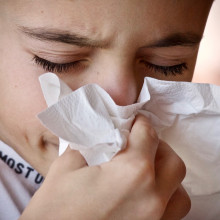
18:41 - Why does light make me sneeze?
Why does light make me sneeze?
Jake wanted to know why some people sneeze when they see bright lights. Chris Smith asked Cambridge physiologist Sam Virtue to explain... Turns out our panel were all familiar with the phenomenon!
Sam - Well, this question is intriguing to me because I one of them. And this is a well described phenomenon, it's called the photic sneeze reflex or, because scientists are funny - autosomal compelling helio ophthalmic outburst or achoo. So this is a classic science joke...
Chris - Is that real? Is that what they really named it?
Sam - Yes they really did that. Essentially, it's the phenomenon that when we stare at a bright light we sneeze. So why this happens, we are not a hundred percent sure. But there are other examples of this, essentially, it's a bit of mis-wiring whereby your body has one sensation or one stimulus and it results in something strange happening. One way its thought possibly happen is the nerves that are essentially responsible for sneezing are also the same nerves which go to our eyes, or the trigeminal nerves.
But actually, I just thought it was a thing that happened but it actually has a couple of major issues. So the first one is fighter pilots, if they are flying into land on an aircraft carrier and its late evening, the whole sea will be lit up as a brilliant shimmering light and they will sneeze if they have this,which will quite possibly result in them crashing into the sea.
Chris - When you're doing a few hundred kilometres an hour, not much margin for error.
Sam - Yup! The Navy came up with an extremely high-tech to this - aviator sunglasses. Yeah, wear some shades and you're no longer have as much light.
But the one it's really terrifying, and I'm not sure if this is safe to say before the watershed because it makes me cringe so badly, is if you are undergoing eye surgery which requires a needle to be put into your actual eyeball they use a sedative called propofol, and the combination of propofol and putting the needle into your eye will trigger this. So surgeons doing this will generally insert the needle and then withdraw it because if you sneeze violently with needle in the middle of your eyeball... yeah.
Chris - Should have gone to Specsavers.
Sam - Yeah.
Chris - Adam?
Adam - I'm gonna shudder for a moment about the eye thing. But how common is this because if you do it and I do it as well so is that very common thing?
Chris - And I do it as well. That's three others out of... You Ljiljana?
Ljiljana - Yeah, yeah.
Chris - Tim, are you sneezer?
Tim - I don't what you're talking about.
Sam - Okay. So we're slightly over-represented here but it's thought to affect between 18 and 35 percent of the population, so it's certainly not rare.
Things that make it worse, for example, and particularly trigger it, I actually used to think it was alcohol was one of them because I would suffer this...
Chris - From personal experience?
Sam - From personal experience. But it turns out that just product of Cambridge having lots of dark, old men pubs because some transitions from dark dim lit areas to brightly lit areas will trigger it particularly powerfully.
Chris - I found it really useful this. You know when you have that horrible thing that happens to you and you want to sneeze but you can't? Well, because I have this and I know this, I facilitate a sneeze that I want to get out by looking at a bright light. And your nodding, Adam, do you do the same trick?
Adam - It makes me look really weird but it's really helpful.
Chris - Stare at the bright light and then achoo, off you go and it feels so much better.
Ljiljana?
Ljiljana- I just wanted to tell you actually Sam, I discovered this a few years ago. I didn't have it before so it's something that developed relatively recently. So it's an interesting fluke of nature, of biology.
Chris - Another weird one, people who stick things into their ear to clean it out, about 2 and a half to 3 percent of the population develop a cough reflex because there’s Arnold nerve in your ear with a cotton bud you will you will get a coughing fit. And many people who have they think they’re totally mad - you’re not, you’re just about one in 50 who have this.
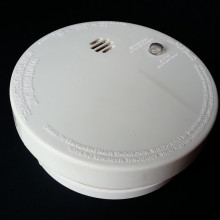
22:40 - How do smoke detectors work?
How do smoke detectors work?
We've all been there, you pop on some dinner, forget about it and then your smoke detectors bursts to life... But how? We received this question from listener Alistair. Chris Smith was joined by technology journalist Tim Revell who explained the science behind these noisy devices.
Tim - Smoke detectors are actually one of those things most people ignore usually. You stick them up on your ceiling and then you never think about them again. But actually inside those fairly plain, white boxes there some quite cool science inside them. So there’s two main ways that they work: the first is called an optical smoke detector and these have an LED light that fires out a small light beam, and there is also a solar panel which is similar to what you might have on your roof. Now if there’s no smoke this light never actually touches the solar panel, but as soon as smoke enters it the light scatters hitting a little bit of the solar panel, creating a little bit of electricity and triggering the alarm which is, if you’ve ever heard one, incredibly annoying and enough to make you get up and check if there’s a fire.
The other type of detector is called an ionisation detector and these are also pretty cool. There are two metal plates and there is also a small radioactive source that produces particles called alpha particles. These what’s called ionise the air in between the plates which essentially means you end with an electrical current between two plates. Know if everything is functioning normally this electrical current just keeps happening and is not interrupted, but as soon as smoke enters the gap you no longer have the electrical current flowing, it triggers the alarm and off it goes and the same thing happens as with the other type of detector.
Chris - Indeed. I think it’s amorisian is the alpha source in your average smoke detector?
Tim - Yeah.
Chris - It’s quite radioactive isn’t it? It’s quite amazing that everyone’s could this radioactive source in their roof so don’t play with it I think is the bottom line, isn’t it?
Tim - Yeah. It’s quite radioactive but these alpha particles don’t travel very far. You don’t need to worry about it. It’s not like they’re producing gamma rays or something that could actually harm you from the ceiling so they never actually escape the little boxes that you keep them in.

24:35 - Why do some mugs change colour with temperature?
Why do some mugs change colour with temperature?
Have you ever had a mug that, when you put a hot cup of tea or coffee in it, it changes colour? Well Ranjay got in touch to ask actually how this works. Chris Smith asked chemist Ljiljana Fruk from Cambridge University to tackle the topic.
Ljiljana - Actually, I do have one of these cups. I love them.
Chris - You've got one?
Ljiljana - Because when you put hot tea in it you see this dinosaur suddenly appearing on the cup which is really beautiful. These kind of materials have been around for ages and they can be of two types. So the one which is used in cups or some toys, it's made of organic dye which are called leuco dyes. So basically, they have structure which is changing with the heat. So they can be, for example, transparent because they don't absorb light and then you heat them up and their molecular structure changes a little bit and suddenly they can absorb light of a different wavelength. And you have many different kinds of dyes, so you can basically draw these patterns on your cup and the moment you put something hot into your cup it will change the colour. Usually they are not very sensitive so it will just detect hot or cold and that's why you would use them for this material. But if you want to be a little bit more precise you might be using liquid crystals which are more expensive. So they can also be made of some kind of organic molecules but they are assembled in a particular way, and as you are heating them you are changing their assembly, you are changing their structure a little bit so they interact with the light in a different way.
Chris - Tim?
Tim - So are these materials used for something else? Because they sound amazing and then a mug is a fairly underwhelming use of such an amazing material!
Ljiljana - Well they are. I mean liquid crystals are used in monitors, in lots of sensors as well, so we use them continuously. So you have LCD displays, they are liquid-crystal displays, so you use them in technology and high-tech industry quite a lot. You would not probably use liquid crystals to make a cup because it will be quite expensive. But what is also really interesting is something that in biology liquid crystals are often used. So for example, materials which are similar will be used by lizards for example, or some types of birds. They also have particular structure which can change and then it will change the colour and this can be with the humidity or the temperature. Even an octopus which can camouflage itself very well uses some kind of structural materials that change with impulses. It's all kinds of materials that are really useful.
Chris - Thank you Ljiljana. So there you go Ranjay, basically a molecule that when you heat it, temporary changes shape and that change in shape means it interacts with one colour of light but not another and reflects a different colour temporarily which is why the colour appears to change. When it cools down, it flips back to how it started and that's why you get your original colour back.
Are you gonna have it in your restaurant, that colour changing cutlery?
Ljiljana - Well actually, I am talking right now to a chemist at the University of Cambridge to give us some of the structural colour to decorate the food. You can have an artistic display on your plate.
Chris - I can't wait!

28:47 - QUIZ: Polar bears, Tobacco & Darth Vader
QUIZ: Polar bears, Tobacco & Darth Vader
with Adam Murphy, Ljiljana Fruk, Tim Revell & Sam Virtue
Its time to put our panel through their paces with our monthly quiz. Team One was physicist Adam Murphy and chemist Ljiljana Fruk who battled their brains against Team Two, technology journalist Tim Revell and physiologist Sam Virtue.
Round 1 is called More or Less.
Chris: Ljiljana and Adam, what weighs more: A polar bear or a shire horse?
Ljiljana - first of all Adam, what is a shire horse?
Adam - Shire horses are those giant giant horses you see police officers riding. They are very scary.
Ljiljana - Okay.
Adam - But polar bears are also equally large and very scary.
Ljiljana - Yes and they have lots of fat. They need to have lots of fat to keep them warm. Is the fat heavier than the muscle?
Adam - Muscle is heavier than fat right?
Chris - I'm gonna have to hurry you.
Adam - Horse I think.
Ljiljana - You think horse?
Adam - They might be trying to trick us but I'm gonna go with horse.
Chris - You're going horse?
Ljiljana - Yes.
A: Shire horse
Chris - Indeed. A polar bear weighs in 720 kg, but a shire horse, a massive 900kg! Just shy of a ton, so they’re very very big.
Team 2, Tim and Sam - Which costs more, a kilo of human blood or a kilo of tobacco?
Tim - Oh, that is a tricky question. Is that wholesale price or after tax?
Sam - Yeah. I was thinking the exact same thing. It feels like it should be the blood doesn't it?
Tim - I would go with that as well.
A: Tobacco.
Chris - In the UK, blood costs around £275 per kilo, once you’ve done the purification process, the storage etc; tobacco though, right, is more expensive, the price is about double that. So it’s about £500 for a kilo of tobacco. So you’re not doing so good!
Right back to team 1 who is Adam and Ljiljana, you’re in the lead with one point.
This round, round 2, is called techYes, or TechNo. Did you see what we did there? Can’t take credit for that, Izzie Clarke came up with that, but, are these ridiculous technologies tech yes, or tech no, in other words are they ones we made up earlier or do they really exist...
- A "Darth Vader" face mask so people can not hear your private conversations in public places. It bleaches them out by playing sounds of animals, ambient noises or even Darth Vader effects, while soaking out the sounds you make!
Ljiljana - This is probably yes.
Adam - I will never underestimate people’s ability to create weird things.
Ljiljana - Yes, and particularly Star Wars inspired. Geeky stuff
Adam - Star Wars yeah, absolutely.
Ljiljana - We think this exists
A: Yes!
Chris - You’re on fire! The Hushme as a crowdsource funding thing, a few years ago. You close the two halves together round your face a bit like a clam shell, around the lower half of your face. It syncs up with your smartphone so you converse in private over Bluetooth with the phone and this absorbent material soaks up the sounds you’re making. And at the same time plays sounds from the library of your phone in to the ambient air, so you mask any sounds that might escape. So you can actually if you want to sound like Darth Vader. You will end up looking like Tom Hardy’s character "Bane", in Dark Knight Rises...
Team 2 - Tech yes, or tech no...
A gaudy-looking ring that measures how much vitamin D you’re making in the sunshine so you can supplement as necessary...
Tim - I mean that could exist. You have tricked us with something plausible.
Sam - I feel no, just in my bones.
Tim - I think we should trust your bones..
Sam - I know but what I’m hoping is it’s like a trick question and it’s a gaudy looking necklace.
Tim - Are that’s it. It’s not a ring it’s necklace. I think we say techno
A: No!
Chris - Although it is a real idea! The Helios Smart Ring was launched for crowdfunding with the aim of calculating sun-generated vitamin D. Unfortunately for the inventors of the concept, the sun didn’t shine on their funding proposal and it got pulled.
Right, Round 3 is called: OUT OF THIS WORLD
Team 1: If an Earth-dwelling Naked Scientist stands on some scales and gets a reading of 68 kilos, would their mass be greater, or smaller on the Moon?
Ljiljana - I’m relying on you Adam.
Adam - Hang on. Their mass stays the same, their weight would change.
Ljiljana - Change - exactly.
Adam - But the mass would stay the same.
Ljiljana - Yes. We say is not going to change
A: The same
Chris - It was indeed a trick question. Their mass - the amount of stuff they are made from - would be the same anywhere in the Universe. Their weight, on the other hand, which is the effect of gravity acting on their mass and is what we measure when you put a mass on a set of scales, would be a lot less on the Moon - in fact about a fifth of the weight - on Earth. Three points to you. Do you want the last question, team 2, because you have actually lost?
Tim - We could do double or nothing?
Chris - Double or nothing on this one… Shall we let them do double or nothing?
Ljiljana - Yes! Let’s do that
Chris - Okay Tim and Sam, Team 2 - Jupiter is 1000 times the mass of the Earth
Tim - True or false, is that the… Mmm, it’s probably about that.
Sam - It’s very big. I kind of almost wonder if it might be bigger than that because how many Earths can you fit in The Big Red Spot? That’s like some huge number isn’t it?
Tim - That’s a lot isn’t it. I think we should say no it’s bigger.
Sam - I think it’s no, it’s bigger
A: No
Chris - It was the right thing to go double or nothing on, because you were right, for the wrong reason - Jupiter is only about 300 times more massive than the Earth.
Adam, do you know how we know this?
Adam - Probably how fast it goes round the Sun.
Chris - Not bad, actually, the reason that we know that is because we’ve got very accurate measurements of the moons of Jupiter going around and you can infer, because we know what the moons are doing, and we know their orbit, how fast they’re going, and how far they are from their host planet Jupiter so you can work out therefore, what the mass of Jupiter must be, by relating it to the Earth, so it’s about 300 times the mass of our own planet. 318 actually is the close number.
So that means we’ve got a tie break situation now. So what this means is that I read you a statement, you have to work out what you think is the number closest to the answer and if you’re the team with the number closest to the one in front of me you get the point, and therefore you clinch the game. The question is:
What is the lifespan of an average tiger?
Tim - I’ll start with a number and say more or less.
Sam - Yeah, looks about right.
Chris - Adam and Ljiljana have you got a number?
Ljiljana - Yes we have.
Chris - Okay. We’ll just toss a coin. Tim and Sam, watch your suggestion? What do you think?
Tim - We’ve done a last-minute change and we’re going for 30.
Chris - 30 years says Tim and Sam. Ljiljana and Adam, what do you think?
Ljiljana - We actually wanted to say 30. Now we are going with 35.
Chris - Are you sure? You’re going with 35
Ljiljana - Yes.
Chris - Sam and Tim... you are the winners! You clinched victory from the jaws of defeat, the answer’s going to surprise you, it’s fifteen, same rough life expectancy as your average pussycat.
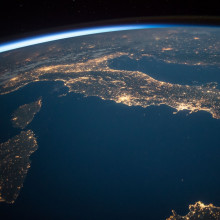
37:55 - Could we colonise another galaxy?
Could we colonise another galaxy?
Jed got in touch on Twitter with this rather ambitious question. Chris Smith asked physicist Adam Murphy to crunch the numbers and it looks like we're staying put. For now...
Adam - I think the answer to this is, unfortunately, unless we have some real new technology... No.
I'm reminded of the Douglas Adams quote from Hitchhiker's Guide to the Galaxy which is "that space is vastly, hugely, mind bogglingly big." So if you think that Voyager 1, the satellite which has left the solar system, that travels at about 17 km every single second. That translates to in space terms one light year, which is the distance light travels in the year. It goes 1 ly every 20,000 years or so and the nearest galaxy to us is about and two and a half million light years away; that's the galaxy Andromeda so 20,000 years to go one light year. We are going a huge distance just to get to that next one. Even Star Trek with all its new technology, unless something very weird happened even they were confined to this galaxy.
Chris - So it's a no from you?
Adam - Unless we can find a way to make wormholes and pierce through space in an instant yeah, probably no.

39:09 - Why do I have cold feet but warm armpits?
Why do I have cold feet but warm armpits?
We received this question from Molatelo. Chris Smith asked physiologist Sam Virtue to strip down the science for us.
Sam - Okay. So this is the rooted in the fact that our bodies control our core body temperature extremely tightly. If you go a couple of degrees higher or a couple of degrees lower than 37 degrees as your core temperature you're in big trouble. But note I keep using the word 'core', that's because whilst your core which will be things like your heart and brain will stay at 37, things like your fingers and toes can cool down much much more because they're not critical for life, and so our body will even sacrifice them and you can lose toes and fingers from frostbite. So in winter if we go out in a cold environment what our body does is it tries to protect our core temperature by constricting the blood vessels that go to our fingers and our toes to keep more of that warmth inside.
Obviously though, we’re humans and we like to be in a temperature where we don't have to use energy to just make heat so we wrap up really warm. Now the body can constrict its blood vessels in seconds using the nervous system, but when you put loads of clothes on you actually have to actively take them off or put them on if you want to change the temperatures. So if you suddenly move from a very cold environment to a slightly warmer one or you start doing some exercise, your body goes from being too cold, to too hot and so it starts to kick in processes to lose heat so it doesn't become too hot - hypothermic. And that includes releasing all the blood into your freezing cold feet but a bit like when you turn a kettle on it doesn't instantly boil, it takes a little while for that hot blood to warm your warm your toes back up, but you’ll be sweating.
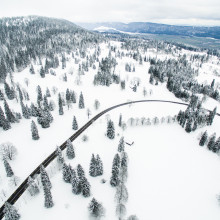
40:59 - DIY Science: Walnuts, Rice and Avalanches
DIY Science: Walnuts, Rice and Avalanches
with Amalia Thomas, University of Cambridge
Grab a jar, fill it with some walnuts, uncooked rice and give it all good shake. Amalia Thomas is a mathematician from Cambridge University who’ll be taking this demo and her research to Parliament as part of a competition called STEM for Britain. She explained to Chris Smith how this work helps to save people from avalanches...
Amalia - Thank you Chris. Adam has prepared this jar thank you very much. And as you might be doing it home I’m shaking it really well.
Chris - That’s worked already.
Amalia - Yeah. Three of four shakes and can you tell me what you see?
Ljiljana - The nuts came on the top.
Amalia - Yeah, the nuts came to the top. So this is a phenomenon that happens in granular systems; these are systems that are made of small solid things, particles - in this case rice and nuts. And it's a very interesting thing that happens in granular systems only that the large materials will always come to the top so this is called size segregation.
Chris - Would that work, Amalia, if the nuts were really heavy? So if had ball bearings in there would it still work?
Amalia - That's a very good point. Size segregation, is only one type, there are other factors which contribute and one of them is density, so if it's larger but a lot denser it would still not rise. Another factor is say surface properties, so if it's very rough it will go up faster.
Chris - And what's the physics of that? What's actually driving that because that was extraordinary, all of the nuts are now perched on top of the rice. All of them and it's within two or three shakes it was phenomenal so why does that happen?
Amalia - Well, that is what my PhD is about. This is something that is still not completely well understood. You might think that the smaller particles are more likely to fit into gaps so they fall but here we've only got a few big ones and they are pushed upwards. The key to that, and for this I'm going to make an analogy with fluid systems, so say with a mudslide, this would not happen in fluid continuous systems because in granular systems forces are not distributed evenly. What that means is some granules carry a lot of weight and some of them don't carry any weight at all and the large particles are more likely to carry weights and, therefore, they’re more likely to be subjected to forces and, as a result they’re levered upwards.
Chris - So it's an average thing is it? Resolves that on average you end with a force being exerted against the big stuff because they're more likely to be pushed somewhere, whereas a small stuff would just slip and slide away and distribute towards the bottom?
Amalia - Yes, to carry weight than small ones.
Chris - Where do we see the same science being manifested in the real world?
Amalia - We see it all the time; we don't know it. This is actually called the breakfast cereal effect and for this I stole my housemate’s granola.
Chris - You really have got a tub of granola.
Amalia - I've got a transparent tub made with a mixture made by my housemate Emily. In here she's got granola, she's got peanuts, walnuts, and coconut.
Chris - And it's all nicely mixed up at the moment? There's no obvious pattern to anything?
Amalia - So we put it on its side and I just give it a little shake, and just with that little shake...
Chris - She could eat three different breakfast with that but now because you've got three different layers in there.
Amalia - I'll put this above my head. Can someone else tell me what they see?
Ljiljana - The bigger things come up.
Amalia - And all the coconut has gone to the bottom, and it's a same phenomenon. Sometimes it's a good thing so this is used in recycling plants when you know you want the different types of garbage separated. And it's a bad thing say in pharmaceutical companies when they want all their active ingredients well mixed.
One big interesting application is in avalanches which is where I actually study this phenomenon. Imagine your free skiers so you're skiing in the mountains and not going through any specific path you get stuck in an avalanche. There is a procedure for that, you have to wear what look like airbags so that if you're caught in an avalanche you pull it and you suddenly become a big particle and then you will rise in the avalanche.
Chris - You literally float to the top of the snow?
Amalia - You will, just like a walnut.
Chris - Does it work?
Amalia - Yeah they do. And they save lives that way because like the walnut you're brought to the top and then your not crushed like everything else that the avalanche has taken with it.
Chris - You might be beaten up a bit but at least you'll be at the top and findable?
Amalia - And findable, which is key, yeah.
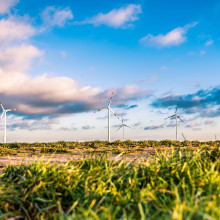
What's the greenest way to heat my home?
Chris Smith was joined by chemist Ljiljana Fruk from Cambridge Univeristy who took on this green question from Katy.
Ljiljana - It's an interesting question. Well definitely something that is very interesting that I also talk to some of the architect friends of mine, is geothermal energy. But of course this would require installing special pumps. So if you are willing to do this it’s basically using the thermal energy of the Earth to heat up your home. The other ways are of course solar energy which is interesting but then again in the production of the solar panels we are investing lots of energy in making these materials and making them cleaner. So it's then a question of processes that are maybe not so green that are going into the production. Natural gas seems to be still okay. And of course it depends on the quality of the gas and so this can also be used. But I would go for a geothermal energy if I had a choice of you know designing my own home.
Sam - I was reading a recent article that actually suggested wind power might be a lot worse for the environment than we thought because the turbines are so large they end up mixing different layers of the atmosphere and actually leading to driving processes that cause global warming. So I think this idea of having different levels of cleanliness of what we think of as renewable or clean energy is really interesting. So you think geothermal is the best?
Ljiljana - Yes. So I mean I think the problem is really that we need to take the whole process into consideration that is not only enough to say ok, this is something which is done which is seemingly renewable, but you have to calculate and look at the whole process. So I would go for a geothermal energy for now.
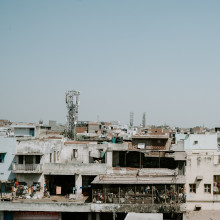
48:39 - Are electromagnetic fields harmful?
Are electromagnetic fields harmful?
Listener Don got in touch via The Naked Scientists forum. Chris Smith asked technology journalist Tim Revell to reveal the truth about EMFs.
Tim - Well it's a very long and detailed question and the short answer is no you don't need to be worried about these. And that you shouldn't get yourself in a bit of a state thinking about them because electromagnetic fields are in so many different things. You see them in mobile phones they come off microwave ovens they come off Wi-Fi routers, computers, the sun. So if they were this terrible conspiracy against us we would have spotted them by now because they are all over the place.
So what actually is an electromagnetic field? Well it's a sort of combined word of an electric field and a magnetic field and you can think of them as just regions of influence. An electric field for example, will manipulate an electric charge, a particle that is electrically charged, and a magnetic field will manipulate something that is magnetic. And the way that we think of these in terms of whether they're harmful or not for us is in terms of how powerful they are and what they might actually do to you.
So the majority of electromagnetic fields that you come into contact with are what's called no- ionizing so these are like your Wi-Fi routers or your mobile phones and things like power lines as well, are all non-ionizing. And that means they won't do any damage to you. And there have been study after study after study that has looked at this and you are absolutely fine. Now there are some electromagnetic fields that are actually bad for us, think things like ultraviolet rays from the sun. We know that if you stand outside in the sun for too long you get sunburnt and that is because ultraviolet rays are not very good for you and also x-rays in medicine are also not very good for you. So if you limit your exposure you're absolutely fine. But if you had too much of them then you could be in trouble.
Chris - Very comprehensive, thank you Tim. I will use my phone with impunity on that basis. I think the answer is that we're doing a massive experiment on the scale of the whole world aren't we? There are more smartphones and mobile devices now than people on the planet. So everyone's using them at some point pretty much and we have got really good exposure data because we know, because most of these devices are phones, how long people are spending on them. And so we actually know roughly what people's doses are. And so people are beginning to relate any health outcome with exposure and looking for a relationship and am I right in saying I don't think yet we've seen one.
Tim - Yeah, absolutely. Every now and again a study surfaces that says oh there's a big issue with mobile phones or mobile phone towers. But when you look into it they are very, very small samples that you can't really make many conclusions from, especially when you compare them to the fact that there are hundreds of studies that have huge samples and huge amounts of data that say otherwise. So if we're going to find that they turn out to have a bad effect it will be from one of these big studies not a tiny, little one you find on a Facebook group on a strange corner of the internet.
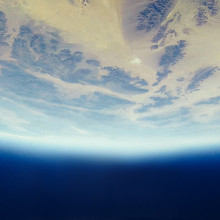
51:41 - Why doesn't space suck away our atmosphere?
Why doesn't space suck away our atmosphere?
This question from listener Nigel is out of this world. Chris Smith asked physicist Adam Murphy to explain why space doesn't suck up our oceans and atmosphere...
Adam - There's two reasons for this. The first one is that Earth is really big. There's a lot of atmosphere but there's a lot more earth and gravity means it will just pull all that air in and pull it in so strongly that it doesn't escape off. Little bits might bounce off the very top of the atmosphere or fly away but so few that we're gonna be fine breathing. The other one is that it doesn't actually hold that much. Space is roughly defined by the Kármán line which is about a hundred kilometres straight up. So that's an hour at motorway speeds in a car. That seems like a lot and we say it's a lot: things like "the sky's the limit". But, if you think that the Earth is about twelve thousand kilometres from one end to the other, but space is only a hundred kilometres up, it actually isn't holding that much atmosphere.The atmosphere is a tiny little shell. So a giant Earth can hold a tiny shell of atmosphere with all its gravity.
Chris - And that's the reason why it doesn’t all get pulled off into space, because there is sufficient gravitational pull on those molecules to hold them against the Earth's surface? And so they don't just whip off into space?
Adam - Exactly, there's too much gravity pulling them down, compressing them against us.
Chris - Because one other argument was that Mars used to have a nice atmosphere, rather like we've got, but that having lost its magnetic field, possibly because it cooled down because it's a much smaller planet, that magnetic field loss meant that the wind coming from the sun, the solar wind, was then able to pluck away, slowly eroding away the atmosphere of Mars. So it turned into the prune of a planet that we've got today. We, luckily, have our magnetic field, so we're protected.
Adam - Yeah that's it. We've still got our shield holding our air to us.
Chris - So we've got gravity hanging onto it and the magnetic shield protecting it...
Adam - And all that together means we still get to breathe.
Related Content
- Previous Why do socks disappear in the wash?
- Next Spacecraft Reunited










Comments
Add a comment